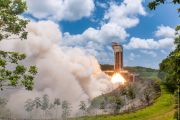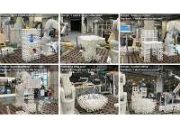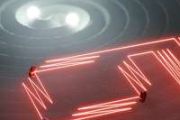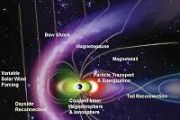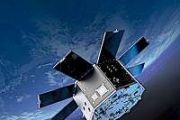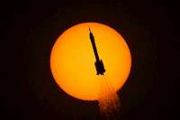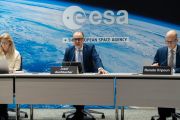
Copernical Team
Russia calls for mechanism to prevent deployment of weapons in space
 Russia calls on the international community to start negotiation on the development of a global mechanism banning the deployment of arms in space, Russian Deputy Foreign Minister Sergey Ryabkov said on Monday.
"The most important task on a global scale is to prevent an arms race in outer space. We call for the launch of negotiations on the development of an international, legally binding i
Russia calls on the international community to start negotiation on the development of a global mechanism banning the deployment of arms in space, Russian Deputy Foreign Minister Sergey Ryabkov said on Monday.
"The most important task on a global scale is to prevent an arms race in outer space. We call for the launch of negotiations on the development of an international, legally binding i NASA provides laser for LISA mission
 Finding the biggest collisions in the universe takes time, patience, and super steady lasers.
In May, NASA specialists working with industry partners delivered the first prototype laser for the European Space Agency-led Laser Interferometer Space Antenna, or LISA, mission. This unique laser instrument is designed to detect the telltale ripples in gravitational fields caused by the mergers
Finding the biggest collisions in the universe takes time, patience, and super steady lasers.
In May, NASA specialists working with industry partners delivered the first prototype laser for the European Space Agency-led Laser Interferometer Space Antenna, or LISA, mission. This unique laser instrument is designed to detect the telltale ripples in gravitational fields caused by the mergers India to revise FDI policy for space sector, says ISRO chief Sivan
 India will soon come out with a new foreign direct investment (FDI) policy for the space sector, Indian Space research Organisation Chairman K. Sivan said on Monday.
In his address at the International Space Conference and Exhibition, organised by Confederation of Indian Industry (CII), on the theme 'Building NewSpace in India', Sivan, who is also Secretary of the Department of Space, said
India will soon come out with a new foreign direct investment (FDI) policy for the space sector, Indian Space research Organisation Chairman K. Sivan said on Monday.
In his address at the International Space Conference and Exhibition, organised by Confederation of Indian Industry (CII), on the theme 'Building NewSpace in India', Sivan, who is also Secretary of the Department of Space, said Dino-killing asteroid set the stage for evolution of modern snakes
 For the majority of species living during the Cretaceous period, the asteroid responsible for Mexico's Chicxulub crater spelled doom. But for those that survived, the catastrophe offered opportunity.
According to a new study, published Tuesday in the journal Nature Communications, the asteroid that wiped out the dinosaurs triggered a period of accelerated diversification among snakes. /
For the majority of species living during the Cretaceous period, the asteroid responsible for Mexico's Chicxulub crater spelled doom. But for those that survived, the catastrophe offered opportunity.
According to a new study, published Tuesday in the journal Nature Communications, the asteroid that wiped out the dinosaurs triggered a period of accelerated diversification among snakes. / Two Flight Engineers' stay extended in ISS
 Two International Space Station crew members have had their stay onboard the orbiting lab extended to nearly a year. Meanwhile, space biology and life support maintenance kept the Expedition 65 crew busy on Tuesday.
With the plans for Russian spaceflight participants to visit the space station as part of the Soyuz MS-19 crew in October 2021, NASA astronaut Mark Vande Hei and Roscosmos cosm
Two International Space Station crew members have had their stay onboard the orbiting lab extended to nearly a year. Meanwhile, space biology and life support maintenance kept the Expedition 65 crew busy on Tuesday.
With the plans for Russian spaceflight participants to visit the space station as part of the Soyuz MS-19 crew in October 2021, NASA astronaut Mark Vande Hei and Roscosmos cosm NASA selects five US companies to mature Artemis Lander concepts
 NASA has selected five U.S. companies to help the agency enable a steady pace of crewed trips to the lunar surface under the agency's Artemis program. These companies will make advancements toward sustainable human landing system concepts, conduct risk-reduction activities, and provide feedback on NASA's requirements to cultivate industry capabilities for crewed lunar landing missions.
The
NASA has selected five U.S. companies to help the agency enable a steady pace of crewed trips to the lunar surface under the agency's Artemis program. These companies will make advancements toward sustainable human landing system concepts, conduct risk-reduction activities, and provide feedback on NASA's requirements to cultivate industry capabilities for crewed lunar landing missions.
The Curtin research shines a light on Moon's oldest geologic imprints
 New Curtin research has found the Moon may have been subjected to much greater impacts from asteroids and other bodies than previously thought, building on our understanding of the Moon's earliest geologic evolution.
Published in Nature Communications, the research provides a greater insight of how the oldest impact events on the Moon may have left near-invisible cratering imprints, offeri
New Curtin research has found the Moon may have been subjected to much greater impacts from asteroids and other bodies than previously thought, building on our understanding of the Moon's earliest geologic evolution.
Published in Nature Communications, the research provides a greater insight of how the oldest impact events on the Moon may have left near-invisible cratering imprints, offeri MDA awarded contract for Japan's Martian Moons Exploration Mission
 MDA Ltd. been awarded the full contract from Mitsubishi Electric in Japan to provide a Laser Rangefinder (LRF) altimeter for the Japan Aerospace Exploration Agency (JAXA) MMX (Martian Moons eXploration) mission.
MDA will be providing two redundant flight units (laser range finder - LRF) altimeters and one engineering development unit (EDU) LRF altimeter.
Scheduled to launch in Japane
MDA Ltd. been awarded the full contract from Mitsubishi Electric in Japan to provide a Laser Rangefinder (LRF) altimeter for the Japan Aerospace Exploration Agency (JAXA) MMX (Martian Moons eXploration) mission.
MDA will be providing two redundant flight units (laser range finder - LRF) altimeters and one engineering development unit (EDU) LRF altimeter.
Scheduled to launch in Japane Visionary tech concepts could pioneer the future in Space
 NASA missions make it seem like the future is now - rovers exploring Mars with cutting-edge gadgets, a spacecraft venturing home with an asteroid sample, and a complex space telescope peering at the early universe. So, what's the next big thing? What might space missions in 2050 and beyond set out to discover?
One small NASA program aims to see what could be possible. The NASA Innovative A
NASA missions make it seem like the future is now - rovers exploring Mars with cutting-edge gadgets, a spacecraft venturing home with an asteroid sample, and a complex space telescope peering at the early universe. So, what's the next big thing? What might space missions in 2050 and beyond set out to discover?
One small NASA program aims to see what could be possible. The NASA Innovative A SpaceX's Inspiration4 civilian crew hopes mission will inspire world
 When the first all-private orbital space mission is launched this week, it will be powered by philanthropist and ambitious businessman Jared Isaacman's vision of making the world a better place.
Isaacman, also a pilot and the mission commander, told UPI when he began assembling his civilian crew in February that he has a long history of tying flights and adventures to fundraising effort
When the first all-private orbital space mission is launched this week, it will be powered by philanthropist and ambitious businessman Jared Isaacman's vision of making the world a better place.
Isaacman, also a pilot and the mission commander, told UPI when he began assembling his civilian crew in February that he has a long history of tying flights and adventures to fundraising effort 














